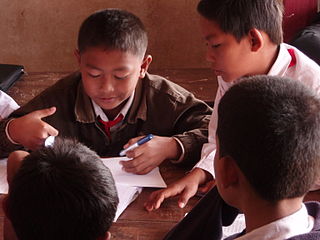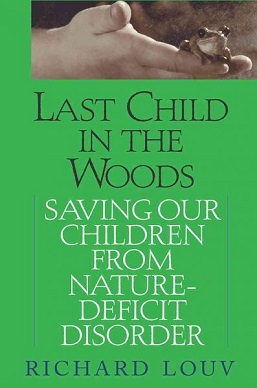Related Research Articles

Attention deficit hyperactivity disorder (ADHD) is a neurodevelopmental disorder characterised by executive dysfunction occasioning symptoms of inattention, hyperactivity, impulsivity and emotional dysregulation that are excessive and pervasive, impairing in multiple contexts, and otherwise age-inappropriate.
Developmental disorders comprise a group of psychiatric conditions originating in childhood that involve serious impairment in different areas. There are several ways of using this term. The most narrow concept is used in the category "Specific Disorders of Psychological Development" in the ICD-10. These disorders comprise developmental language disorder, learning disorders, motor disorders, and autism spectrum disorders. In broader definitions ADHD is included, and the term used is neurodevelopmental disorders. Yet others include antisocial behavior and schizophrenia that begins in childhood and continues through life. However, these two latter conditions are not as stable as the other developmental disorders, and there is not the same evidence of a shared genetic liability.
Cognitive disengagement syndrome (CDS) is an attention syndrome characterised by prominent dreaminess, mental fogginess, hypoactivity, sluggishness, slow reaction time, staring frequently, inconsistent alertness, and a slow working speed. To scientists in the field, it has reached the threshold of evidence and recognition as a distinct syndrome.

Health education is a profession of educating people about health. Areas within this profession encompass environmental health, physical health, social health, emotional health, intellectual health, and spiritual health, as well as sexual and reproductive health education.
Forest school is an outdoor education delivery model in which students visit natural spaces to learn personal, social and technical skills. It has been defined as "an inspirational process that offers children, young people and adults regular opportunities to achieve and develop confidence through hands-on learning in a woodland environment". Forest school is both a pedagogy and a physical entity, with the use often being interchanged. The plural "schools" is often used when referring to a number of groups or sessions.

Despite the scientifically well-established nature of attention deficit hyperactivity disorder (ADHD), its diagnosis, and its treatment, each of these has been controversial since the 1970s. The controversies involve clinicians, teachers, policymakers, parents, and the media. Positions range from the view that ADHD is within the normal range of behavior to the hypothesis that ADHD is a genetic condition. Other areas of controversy include the use of stimulant medications in children, the method of diagnosis, and the possibility of overdiagnosis. In 2009, the National Institute for Health and Care Excellence, while acknowledging the controversy, stated that the current treatments and methods of diagnosis are based on the dominant view of the academic literature.
Attention deficit hyperactivity disorder management options are evidence-based practices with established treatment efficacy for ADHD.

Nature-deficit disorder is the idea that human beings, especially children, are spending less time outdoors than they have in the past, and the belief that this change results in a wide range of behavioral problems.
F. Xavier Castellanos is a Bolivian neuroscientist who is the director of research at the NYU Child Study Center. His work aims at elucidating the neuroscience of ADHD through structural and functional brain imaging studies, collaborating on molecular genetic studies, and coordinating an interdisciplinary network of translational investigators. Dr. Castellanos chaired the NIH ‘Initial Review Group’ on Developmental Psychopathology and Developmental Disabilities from 2005–2007 and is chairing the revision of the diagnostic criteria for externalizing disorders for the forthcoming edition of DSM-V, projected for 2012. He continues to make significant contributions to research into the neurobiological substrates of attention deficit hyperactivity disorder.
The National Wildlife Federation recommends that parents give their kids a "Green Hour" every day, a time for unstructured play and interaction with the natural world. This is part of NWF's strategy called Reversing Nature Deficit. The Green Hour program teaches that unstructured play can take place in a garden, a backyard, a nearby park, or any place that provides safe and accessible green spaces where children can learn and play.

Last Child in the Woods: Saving Our Children From Nature-Deficit Disorder is a 2005 book by author Richard Louv that documents decreased exposure of children to nature in American society and how this "nature-deficit disorder" harms children and society. The author also suggests solutions to the problems he describes. A revised and expanded edition was published in 2008.

Richard Louv is an American non-fiction author and journalist. He is best known for his seventh book, Last Child in the Woods: Saving Our Children From Nature-Deficit Disorder, which investigates the relationship of children and the natural world in current and historical contexts. Louv created the term "nature-deficit disorder" to describe possible negative consequences to individual health and the social fabric as children move indoors and away from physical contact with the natural world – particularly unstructured, solitary experience. Louv cites research pointing to attention disorders, obesity, a dampening of creativity and depression as problems associated with a nature-deficient childhood. He amassed information on the subject from practitioners of many disciplines to make his case and is commonly credited with helping to inspire an international movement to reintroduce children to nature.
Mental disorders diagnosed in childhood can be neurodevelopmental, emotional, or behavioral disorders. These disorders negatively impact the mental and social wellbeing of a child, and children with these disorders require support from their families and schools. Childhood mental disorders often persist into adulthood. These disorders are usually first diagnosed in infancy, childhood, or adolescence, as laid out in the DSM-5 and in the ICD-11.

Jennifer Colleen Douglas is an American writer/producer and activist. She has worked in film, video, television, radio, print and Internet projects. She is the writer and co-producer of the 2012 documentary film, Save KLSD: Media Consolidation & Local Radio.
Youth is an age group in the demographics of the United States. In 2010, it was estimated that 20.2% of the population of the United States were 0–14 years old.
OpEPA - Organización para la Educación y Protección Ambiental / Organization for Environmental Education and Protection Corp (USA) is a non-governmental environmental education organization with offices in Colombia and USA.

Childhood acquired brain injury (ABI) is the term given to any injury to the brain that occurs during childhood but after birth and the immediate neonatal period. It excludes injuries sustained as a result of genetic or congenital disorder. It also excludes those resulting from birth traumas such as hypoxia or conditions such as foetal alcohol syndrome. It encompasses both traumatic and non-traumatic injuries.
Disinhibited Social Engagement Disorder (DSED), or Disinhibited Attachment Disorder, is an attachment disorder in which a child has little to no fear of unfamiliar adults and may actively approach them. It can significantly impair young children's abilities to relate with adults and peers, according to the Diagnostic and Statistical Manual of Mental Disorders. As well as put them in dangerous and potentially unsafe conditions. Common examples of this include sitting on a person's lap of which they do not know or leaving with a stranger.

Stephen P. Hinshaw is an American psychologist whose contributions lie in the areas of developmental psychopathology and combating the stigma that surrounds mental illness. He has authored more than 325 scientific articles and chapters as well as 14 authored and edited books. Currently, he is Professor in the Department of Psychology at the University of California, Berkeley, and Professor In Residence and Vice Chair for Child and Adolescent Psychology in the Department of Psychiatry at the University of California, San Francisco. His work focuses on child and adolescent mental disorders, clinical interventions, mechanisms of change in psychopathology, and stigma prevention efforts, with a specialization in ADHD and other neurodevelopmental disorders.
Social emotional development represents a specific domain of child development. It is a gradual, integrative process through which children acquire the capacity to understand, experience, express, and manage emotions and to develop meaningful relationships with others. As such, social emotional development encompasses a large range of skills and constructs, including, but not limited to: self-awareness, joint attention, play, theory of mind, self-esteem, emotion regulation, friendships, and identity development.
References
- ↑ "Marti Erickson | Erin Erickson | About ME | Mom Enough". Mom Enough. Retrieved February 28, 2017.
- ↑ "Board of Directors". Children & Nature Network. Retrieved February 28, 2017.
- ↑ "Board of Directors". Children & Nature Network. Retrieved February 28, 2017.
- ↑ "Suffering from 'nature-deficit disorder'", The Dallas Morning News
- ↑ Kuo, F. E.; Faber Taylor, A (2004). "A Potential Natural Treatment for Attention-Deficit/Hyperactivity Disorder: Evidence From a National Study". American Journal of Public Health . 94 (9): 1580–1586. doi:10.2105/ajph.94.9.1580. PMC 1448497 . PMID 15333318.